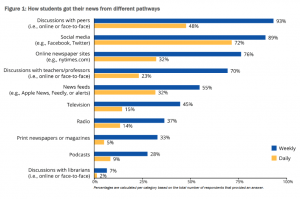Project Information Literacy (a nonprofit research institute that I work with) just released a large-scale study of how college students seek, interact with, and understand news. For this study, we surveyed just under 6,000 college students about how they encounter, evaluate, process, and share news in their daily lives.
One of the major findings is the multi-modal approach college students take to news consumption. This means that college students rely on no single way of getting their news. Within these many modes, students are most likely to get news from discussions with peers (93%) than any other mode of communication, including social media (89%). The study also found that more than a third (36%) of students surveyed were cynical of any news source due to the emergence of “fake news.” Follow up interviews with students revealed that they have mitigated this cynicism by learning to “read laterally” and check validity across multiple sources before sharing or re-posting a news story.

The report makes several recommendation for instructors, journalists, and librarians. Two that could be especially applicable at UW Tacoma are the recommendation that a more nuanced approach to teaching source evaluation will serve students better as they attempt to translate their academic skills into life skills. This means moving beyond identifying peer-reviewed and primary sources, and looking at the content, not the format of a source. Additionally, the report suggests integrating the discussion of news into the classroom will give instructors the chance to act as guides, modeling critical inquiry and building the skills to be effective news consumers.
Check out the report, written by lead investigator, Dr. Alison Head, and co-researchers John Whibey, Dr. Takis Metaxis, Margy MacMillan and Dr. Dan Cohen.